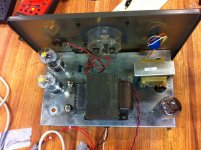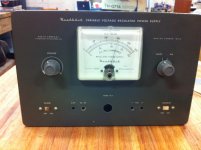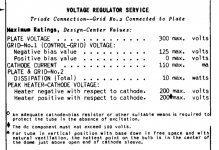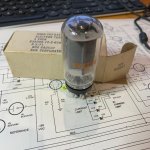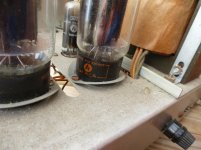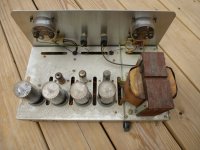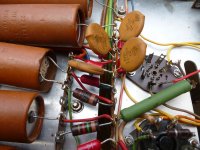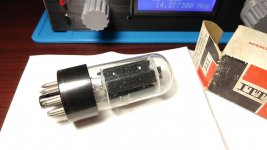From FleaBay I bought a mediocre Heathkit PS-3 Power Supply, the predecessor to the much better PS-4 and IP-32. Turns out is wasn't quite up to "mediocre"; the seller didn't remove the tubes, and both 1619s fell out and got their guide pins busted. Plus, the original builder apparently used 1/4" solder and a heavy hand, so every solder joint had big globs of solder (poor kit builders are always a risk with Heathkits, of course).
Never liked the PS-3 design anyway (the pass-tubes are 1619, which are directly heated beam tetrodes with 2.5V/2A (!) filaments; Heathkit likely got a huge stock from WWII surplus), so I decided to rebuild it as an SE or small PP prototype Power Supply using my favorite Black Sheep tube, the Sylvania 6AV5GA.
Kit power supplies of the era (the later Heathkits, plus the EICO 1050, for example) often used 6L6s as pass-tubes, usually the GCs in later models, but I figured somebody had to have used the 6AV5GA, probably triode strapped. as it was (and is) a lot cheaper than the 6L6GC (audio) tube, and was close to ideal as a pass-tube when triode strapped.
Indeed BOTH General Radio AND HP used either the 6AV5GA or its cousin the 6AU5GT as pass tubes. The best implementation was the P/S in the HP 202A Function Generator, which used a 5U4GB + CLC filter, which I preferred.
Tubes were 2 x 6AV5GAs + 6AU6 error amp + 0A2 cold diode ~150V voltage reference tube. I have several dozen 6AU6s, and two 0A2s came with the PS-3, and I have half a dozen well-seasoned 6AV5GAs.
I removed the old 6SJ7 octal error amp and the 6X5 bias rectifier, which left enough room for a Triad CX-14 choke. Reworked the reference voltage divider in the HP circuit, including a 100K 10 turn pot, so the circuit would be centered on 300 volts, and adjustable from about 250-350VDC output, depending on current. Otherwise it's the stock HP circuit, except of course that the Heathkit transformer is 380-0-380 instead of the 475-0-475 HP PST.
I stayed with the 0A2 tube voltage reference because (a) it's a TUBE (duh) and (b) it makes a nice purple glow (see (a)). A zener would likely be more consistent but subject to thermal drift; cold cathode tubes apparently can have slightly different values each time they are started-up, but don't drfit as much with temperature. Besides, Zeners need to be decorated (ie bypassed) with a couple of caps to eliminate the avalanche noise; well, I guess unless you use a string of 6.3 volt ones. Purple Glow Tube it is.
I set the pot exactly mid-span and powered it up with a 2K ohm load; after about 10 seconds, the meter needle swung-up to 300 VDC, spot-on, and stuck there. Current was spot on at 150ma.
Subsequently I've been heating the shop with my little resistor bank at 310V and 160mA just to see how the 6AV5s like the continuous high current. No embarrassing redness after the first hour. This isn't surprising, since I've run Sylvania 6AV5GAs (including these exact tubes) at 80 mA in a Simple SE without problems.
Unfortunately, the PST is barely warm pushing 160mA, so I am obviously a woosie. I need to scrounge-up some more load resistors.
See the photos below.
I completely disassembled the badly-built PS-3, salvaged the sockets and the needed power resistors, cleaned-up the chassis, and rewired. All told, took about ten hours. Only new significant part was a $12 Bourne 10-turn 100K pot (the blue thing on the panel); one turn equals about 10VDC (a little too fine) so I might adjust the voltage divider resistors to make the adjustment more coarse.
The power supply schematic is in the HP 202A manual at www.hparchive.com/Manuals/HP-202A-Manual-SNprefix-037.pdf if anybody is interested.
I figure I'll add a S/S bias voltage supply for fun; S/S seems to be a really good idea for a bias supply; bias turn-on is practically instant, so there's a bias voltage on your grids long before the B+ hits the plates.
Never liked the PS-3 design anyway (the pass-tubes are 1619, which are directly heated beam tetrodes with 2.5V/2A (!) filaments; Heathkit likely got a huge stock from WWII surplus), so I decided to rebuild it as an SE or small PP prototype Power Supply using my favorite Black Sheep tube, the Sylvania 6AV5GA.
Kit power supplies of the era (the later Heathkits, plus the EICO 1050, for example) often used 6L6s as pass-tubes, usually the GCs in later models, but I figured somebody had to have used the 6AV5GA, probably triode strapped. as it was (and is) a lot cheaper than the 6L6GC (audio) tube, and was close to ideal as a pass-tube when triode strapped.
Indeed BOTH General Radio AND HP used either the 6AV5GA or its cousin the 6AU5GT as pass tubes. The best implementation was the P/S in the HP 202A Function Generator, which used a 5U4GB + CLC filter, which I preferred.
Tubes were 2 x 6AV5GAs + 6AU6 error amp + 0A2 cold diode ~150V voltage reference tube. I have several dozen 6AU6s, and two 0A2s came with the PS-3, and I have half a dozen well-seasoned 6AV5GAs.
I removed the old 6SJ7 octal error amp and the 6X5 bias rectifier, which left enough room for a Triad CX-14 choke. Reworked the reference voltage divider in the HP circuit, including a 100K 10 turn pot, so the circuit would be centered on 300 volts, and adjustable from about 250-350VDC output, depending on current. Otherwise it's the stock HP circuit, except of course that the Heathkit transformer is 380-0-380 instead of the 475-0-475 HP PST.
I stayed with the 0A2 tube voltage reference because (a) it's a TUBE (duh) and (b) it makes a nice purple glow (see (a)). A zener would likely be more consistent but subject to thermal drift; cold cathode tubes apparently can have slightly different values each time they are started-up, but don't drfit as much with temperature. Besides, Zeners need to be decorated (ie bypassed) with a couple of caps to eliminate the avalanche noise; well, I guess unless you use a string of 6.3 volt ones. Purple Glow Tube it is.
I set the pot exactly mid-span and powered it up with a 2K ohm load; after about 10 seconds, the meter needle swung-up to 300 VDC, spot-on, and stuck there. Current was spot on at 150ma.
Subsequently I've been heating the shop with my little resistor bank at 310V and 160mA just to see how the 6AV5s like the continuous high current. No embarrassing redness after the first hour. This isn't surprising, since I've run Sylvania 6AV5GAs (including these exact tubes) at 80 mA in a Simple SE without problems.
Unfortunately, the PST is barely warm pushing 160mA, so I am obviously a woosie. I need to scrounge-up some more load resistors.
See the photos below.
I completely disassembled the badly-built PS-3, salvaged the sockets and the needed power resistors, cleaned-up the chassis, and rewired. All told, took about ten hours. Only new significant part was a $12 Bourne 10-turn 100K pot (the blue thing on the panel); one turn equals about 10VDC (a little too fine) so I might adjust the voltage divider resistors to make the adjustment more coarse.
The power supply schematic is in the HP 202A manual at www.hparchive.com/Manuals/HP-202A-Manual-SNprefix-037.pdf if anybody is interested.
I figure I'll add a S/S bias voltage supply for fun; S/S seems to be a really good idea for a bias supply; bias turn-on is practically instant, so there's a bias voltage on your grids long before the B+ hits the plates.
Attachments
6AV5 Regulated Power Supply; Resurrected Thread
I'm posting this HERE in TubeLab because
(a) not clear what other forum would have it,
(b) it's an overdue extension of the post above, and
(c) TubeLab is the Home of the 6AV5 (and other misbegotten, usually sweep, tubes) after all.
After a decade absence from thermionic stuff, I'm back making high-voltage mistakes, uh, experiments... and I find the need for a beefier power supply.
I have a minty Heathkit IP-32, a partially restored PS-4 (same circuit) and a disassembled PS-3 (above; don't ask why it's disassembled, I do not remember). All are limited to 100 ma.
I would LIKE a nice Fluke or Lambda or similar, but they got expensive all of a sudden, and nowadays time is cheaper than money now. Besides, I have
the iron (e.g. Tek scope PST) and glass (about forty 6AV5s).
I favor Pete Millett's Bench Power Supply, which is essentially a Heathkit on steroids, coincidentally using the exact Tektronix PST I have.
High-voltage bench supply
I believe I have everything on this schematic except maybe the 12BY7 and a VR90...
What I DON'T know is how to determine much current I can get through a 6AV5 pass tube, particularly since the 11 watt plate dissipation (book) rating is obviously conservative (by ~100% per my Class A experiments)
This is largely an academic question, since I have a surfeit of 6AV5s; I can just use 4 each in parallel and get my 200mA with only 50mA across each tube. However, if I can safely get 70 or 100mA per tube...
So, how to proceed (that is, OTHER than Build & Test To Failure).
PS note that the Millet PS has a separate ~200V screen supply, so screen-to-plate voltage isn't an issue.
PPS My 6AV5 SSE amp, running at ~410 V plate and about 23W dissipation has about 150 hours on it. Well past infant mortality stage...Got new Eminence Beta 12LTA ~98dB/W drivers for the kitchen cabinet open baffles, and now have BASS from a 6AV5 SE UL amp, maybe 7W/channel...
I'm posting this HERE in TubeLab because
(a) not clear what other forum would have it,
(b) it's an overdue extension of the post above, and
(c) TubeLab is the Home of the 6AV5 (and other misbegotten, usually sweep, tubes) after all.
After a decade absence from thermionic stuff, I'm back making high-voltage mistakes, uh, experiments... and I find the need for a beefier power supply.
I have a minty Heathkit IP-32, a partially restored PS-4 (same circuit) and a disassembled PS-3 (above; don't ask why it's disassembled, I do not remember). All are limited to 100 ma.
I would LIKE a nice Fluke or Lambda or similar, but they got expensive all of a sudden, and nowadays time is cheaper than money now. Besides, I have
the iron (e.g. Tek scope PST) and glass (about forty 6AV5s).
I favor Pete Millett's Bench Power Supply, which is essentially a Heathkit on steroids, coincidentally using the exact Tektronix PST I have.
High-voltage bench supply
I believe I have everything on this schematic except maybe the 12BY7 and a VR90...
What I DON'T know is how to determine much current I can get through a 6AV5 pass tube, particularly since the 11 watt plate dissipation (book) rating is obviously conservative (by ~100% per my Class A experiments)
- Commercial power supplies get ~70mA thru one 6AV5, e.g. General Radio 1201C.
- The first-cousin 6AU5GT data sheet actually lists 100mA cathode current limit for voltage regulator service, but no such datum on the 6AV5 data sheet.
- In my own brief trials (above) I was pushing 160mA thru two 6AV5 will no signs of ill effects (although Heathkit PST was getting toasty)
This is largely an academic question, since I have a surfeit of 6AV5s; I can just use 4 each in parallel and get my 200mA with only 50mA across each tube. However, if I can safely get 70 or 100mA per tube...
So, how to proceed (that is, OTHER than Build & Test To Failure).
PS note that the Millet PS has a separate ~200V screen supply, so screen-to-plate voltage isn't an issue.
PPS My 6AV5 SSE amp, running at ~410 V plate and about 23W dissipation has about 150 hours on it. Well past infant mortality stage...Got new Eminence Beta 12LTA ~98dB/W drivers for the kitchen cabinet open baffles, and now have BASS from a 6AV5 SE UL amp, maybe 7W/channel...
Attachments
The 6AU5, 6AV5GT, 6AV5GA, 6BQ6GT, 6BQ6GA and many others all use the same cathode. The maximum average cathode current in all specs TV sweep and others is 110 mA. In TV sweep use the cathode current ramps from zero to a lot, returns to zero for a few mS, then "sweeps" upward again. The term "sweep" refers to the current in the magnetic coil (deflection yoke) around the picture tube that deflects the electron beam "sweeping" it across the face of the TV screen. Since the current spends some time sitting at zero while the (cutoff) electron beam "flies back" across the CRT face, the maximum current is more than twice the average. This is not the case in power supply or sine wave audio duty.
The "flying back" is where the term flyback comes from as the design is still used in low cost SMPS circuits today. We just leave out the CRT and magnetic deflection yoke.
Both the maximum peak current, and the continuous cathode current ratings should be observed in audio, TV, and power supply duty. The plate dissipation rating should be observed for any long term use. Obviously the larger 6AV5GA and 6BQ6GA can eat more power than the smaller tubes. many of the later versions of the GE tube use the GE 17 watt plate design found in all of the later GE 17 and 18 watt tubes. 20 watts should be fine.
Pete's HV supply used 807's if I remember right. Just about any tube could be used here if the screen grid voltage circuit is modified. 12BY7's were common TV video output tubes. I had boxes full, and still have several, all used pulls from junk. They are used in several popular HiFi amps and several popular ham radio sets, so they are getting scarce. Any pentode with a Gm of around 10000 could be made to work.
I bought an old Knight Kit power supply at a hamfest over 20 years ago for $20. It worked well and ignored all of my abuse for years so I never took it apart. After my 41 year engineering career came to an end I packed up all my stuff and moved out of Florida. the Knight Kit and a Fluke 407D both spent one of the coldest winters here in an unheated trailer.
Upon re-awakening the Fluke worked fine, but the familiar stink of blown electrolytic caps came out of the Knight Kit. I had the manual with schematic and parts list (included here), so it was rebuild time. I was aiming for a zero cost rebuild using parts at hand, but that was not the case. This one turned out to be a negative cost rebuild. How?
As soon as I opened the power supply I realized why the original builder asked why I wanted it. Those tubes are "audiophool grade" RCA black plate 6L6GC's. I ran them in a test SSE and they did sound nice, and all biased up to a similar current, so I sold them at a hamfest.
The burnt resistor pointed right at the cap that had vented, note the crispy white stuff on it's end. I replaced all the electrolytics and the fried resistor. The power supply still puts up with my abuse, including momentary dead shorts with its "EBAY grade" $5 Chinese 6L6GC's.
The "flying back" is where the term flyback comes from as the design is still used in low cost SMPS circuits today. We just leave out the CRT and magnetic deflection yoke.
Both the maximum peak current, and the continuous cathode current ratings should be observed in audio, TV, and power supply duty. The plate dissipation rating should be observed for any long term use. Obviously the larger 6AV5GA and 6BQ6GA can eat more power than the smaller tubes. many of the later versions of the GE tube use the GE 17 watt plate design found in all of the later GE 17 and 18 watt tubes. 20 watts should be fine.
Pete's HV supply used 807's if I remember right. Just about any tube could be used here if the screen grid voltage circuit is modified. 12BY7's were common TV video output tubes. I had boxes full, and still have several, all used pulls from junk. They are used in several popular HiFi amps and several popular ham radio sets, so they are getting scarce. Any pentode with a Gm of around 10000 could be made to work.
I bought an old Knight Kit power supply at a hamfest over 20 years ago for $20. It worked well and ignored all of my abuse for years so I never took it apart. After my 41 year engineering career came to an end I packed up all my stuff and moved out of Florida. the Knight Kit and a Fluke 407D both spent one of the coldest winters here in an unheated trailer.
Upon re-awakening the Fluke worked fine, but the familiar stink of blown electrolytic caps came out of the Knight Kit. I had the manual with schematic and parts list (included here), so it was rebuild time. I was aiming for a zero cost rebuild using parts at hand, but that was not the case. This one turned out to be a negative cost rebuild. How?
As soon as I opened the power supply I realized why the original builder asked why I wanted it. Those tubes are "audiophool grade" RCA black plate 6L6GC's. I ran them in a test SSE and they did sound nice, and all biased up to a similar current, so I sold them at a hamfest.
The burnt resistor pointed right at the cap that had vented, note the crispy white stuff on it's end. I replaced all the electrolytics and the fried resistor. The power supply still puts up with my abuse, including momentary dead shorts with its "EBAY grade" $5 Chinese 6L6GC's.
Attachments
Both the 6AV5GA and the cute little 6AU5GT have "average" transconductance of 5500 mhos, which is in the same ballpark as the 6L6 family, and the 807s that Pete Millett used.
I assume that high transconductance (e.g. 10000 mhos) is a good thing in pass tubes, as it's an indication of the efficiency of the pass tube as a "switch" (or, in Brit Speak, a "valve"). Is that a correct way to think about it?
I am still confused, though, about current limits for pass tubes in general, and for the SYLVANIA 6AV5GT in particular (as we know that it can take about double the "book" current).
It appears that the dissipation in a pass tube is the max Vpk (source on cathode to output from plate) times the amperage.
Assuming that a Sylvania 6AV5GA can comfortably take 20W dissipation, that means that we could draw 50 mA at a 400V delta across the tube. Is it really that simple?
For example, if I want to get 200mA from say three 6AV5s at 20W dissipation, I would have to limit the voltage drop to 300V, either by raising the minimum output voltage or lowering the source voltage.
(a) is that arithmetic correct? and (b) is 20W a good guess for Sylvania 6AV5GAs, do you suppose? (I know that the answer is "it depends; try it", but what's the collective best guess?)
Now that I think about it, all the voltage regulators I've found which used the 6AV5GA & 6AU5GA are FIXED (not variable) output; i.e. very small Vpk.
PS there's just enough filament current from that Tek PST for five 6AV5s.
PPS Looking at FleaBay, it appears that the cheapest $/watt is STILL probably Chinese 6L6GCs, which is what I've been using in my Heathkits.
(like George, I found nice 6L6/5881s in the Heathkit PS-4 and IP-32, but stashed 'em). Even cheaper than 807s which is surprising since I figured the cathode cap would keep the 807 price low...
Maybe I'll just save the 6AV5s for the screen-drive PP amp in my future...
I assume that high transconductance (e.g. 10000 mhos) is a good thing in pass tubes, as it's an indication of the efficiency of the pass tube as a "switch" (or, in Brit Speak, a "valve"). Is that a correct way to think about it?
I am still confused, though, about current limits for pass tubes in general, and for the SYLVANIA 6AV5GT in particular (as we know that it can take about double the "book" current).
It appears that the dissipation in a pass tube is the max Vpk (source on cathode to output from plate) times the amperage.
Assuming that a Sylvania 6AV5GA can comfortably take 20W dissipation, that means that we could draw 50 mA at a 400V delta across the tube. Is it really that simple?
For example, if I want to get 200mA from say three 6AV5s at 20W dissipation, I would have to limit the voltage drop to 300V, either by raising the minimum output voltage or lowering the source voltage.
(a) is that arithmetic correct? and (b) is 20W a good guess for Sylvania 6AV5GAs, do you suppose? (I know that the answer is "it depends; try it", but what's the collective best guess?)
Now that I think about it, all the voltage regulators I've found which used the 6AV5GA & 6AU5GA are FIXED (not variable) output; i.e. very small Vpk.
PS there's just enough filament current from that Tek PST for five 6AV5s.
PPS Looking at FleaBay, it appears that the cheapest $/watt is STILL probably Chinese 6L6GCs, which is what I've been using in my Heathkits.
(like George, I found nice 6L6/5881s in the Heathkit PS-4 and IP-32, but stashed 'em). Even cheaper than 807s which is surprising since I figured the cathode cap would keep the 807 price low...
Maybe I'll just save the 6AV5s for the screen-drive PP amp in my future...
Oh, and one more thing: whilst rummaging, er, Continuing to Clean the Shop, I came across FOUR of these cute little buggers...
I just bumped into a quad of 6AU5GT while rummaging through a box of tubes in the back of my office. No coin base on mine, but beautiful dark black plates.
So many tubes, so little time left.
Attachments
- Status
- This old topic is closed. If you want to reopen this topic, contact a moderator using the "Report Post" button.
